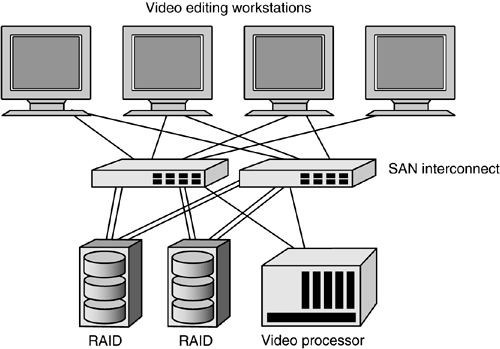12.1 Post-Production Video Editing
| As one of the first applications to employ high-performance SAN technology, full-motion video editing leverages the bandwidth, distance, and shared resources that SAN technology enables. Digitized video has several unique requirements that exceed the capabilities of legacy data transports, including the sustained transmission of multiple gigabit streams and intolerance for disruption or delays. Most SAN-based video applications use the SCSI-3 protocol to move data from disk to workstations, although custom configurations have been engineered using IP for multicast and broadcast distribution. Video applications have common high-performance transport requirements but may vary considerably in content. A video editing application can center on a workgroup configuration, as shown in Figure 12-1, allowing peer workstations to access and modify video streams from one or more disk arrays. In addition to the physical SAN topology, any application that allows data sharing must have software support for file access and locking by multiple users. A video broadcast application that serves content from a central data source to multiple feeds must have the means to support multicast across the SAN. Video used for training applications may support both editing workstations and user stations, with random access to shared video clips or to instructional modules digitized on disk. Figure 12-1. A peer video editing SAN via a switched fabric
In this example, the bandwidth required per workstation depends on the type of video streams retrieved from and stored to disk. Standard digitized streams may require ~30MBps throughput, whereas high-definition video requires ~130MBps. In the latter case, 2Gbps Fibre Channel would support ~400MBps full duplex, or sufficient bandwidth for a high-definition video stream to be read from disk, processed, and written back concurrently. The configuration shows dual pathing between the video editing workstations and redundant SAN switches. Device drivers for the host adapter cards must therefore support failover in case a link or switch is lost, and preferably load balancing to fully utilize both paths during normal operation. In addition, the ratio of server to storage links must be adequate to support concurrent operation by all workstations. Larger storage arrays support multiple links so that a nonblocking configuration can be built. Video editing applications are intolerant of latency or delays. For optimal jitter-free performance, video data can be written to the outer tracks of in dividual disks within the storage array. Although this technique reduces the total usable capacity, it requires less disk head movement for reading and writing data and thus minimizes latency in disk performance. |
EAN: 2147483647
Pages: 171
